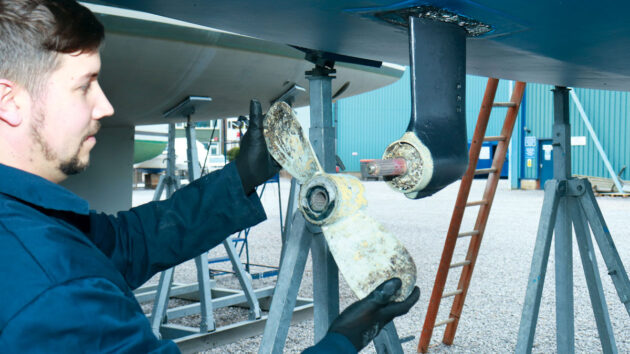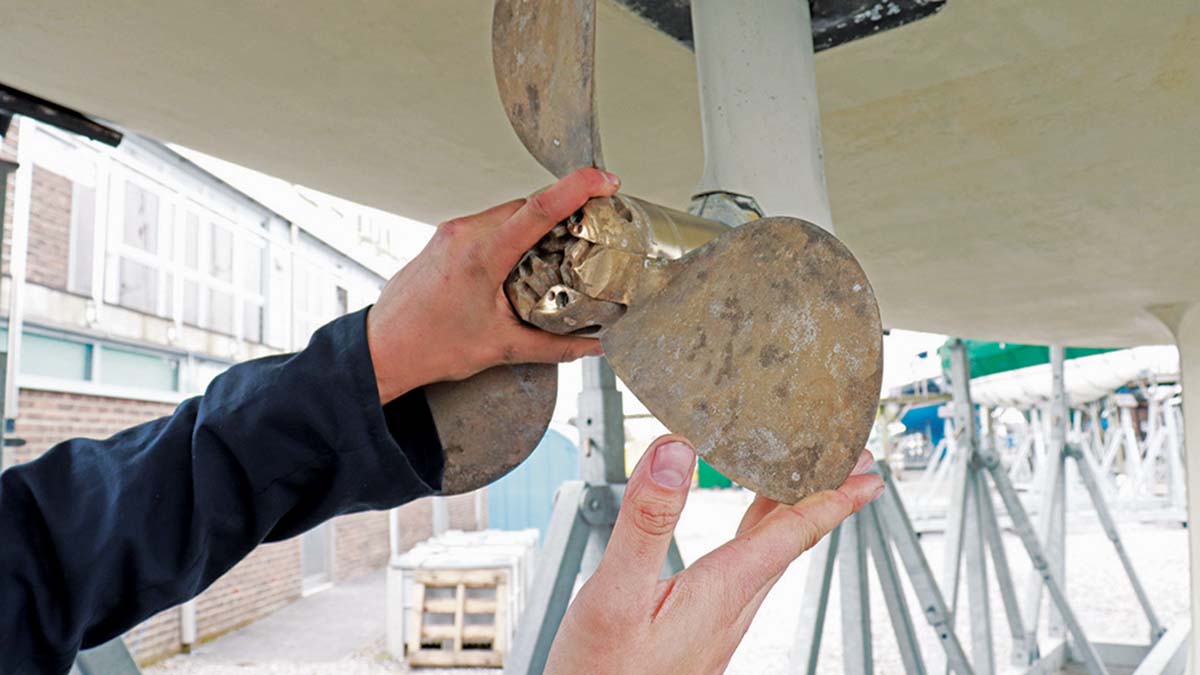Stu Davies shares his tips for making sure your boat's saildrive runs smoothly
Maintaining a saildrive is just as important as engine care, given its role in ensuring smooth motoring.
I am most familiar with Volvo Penta saildrives so this article will focus on that make, but other manufacturers make them – all are basically of a similar design and layout.
Saildrives are the method of getting power to a propeller easily and relatively cheaply; cut a hole in the hull moulding, drop an engine and propulsion package in, seal with a big rubber gasket and that’s it.
There are no shaft-to-propeller-to-engine alignment problems, no tricky through-hull tubes to align and no leaky propeller shaft seals.
However, like all things in life, they have issues. A saildrive does not need a deep water seal but it does have lip seals on the propeller stub shaft.

Note the reaction between the copper-based antifoul paint and the saildrive leg. Credit: Stu Davies
If you’re unlucky enough to get a fishing line wrapped around the saildrive the seal will soon be destroyed, allowing seawater to enter the drive.
This mixes with the oil in there to form an emulsion.
Saildrives are made of aluminium, a good, strong light metal but one which is easily corroded by seawater and other metals if steps are not taken to protect it.
They’re bolted onto the back of the engine and have two right angle gears converting the drive from horizontal to vertical to horizontal again.
Saildrives have a forward and reverse gear, as well as four pinions to convert the drive to get the power down and out.
These are highly stressed ‘contact’ pinions and require specialised oil which is usually used in the back axles of cars.

The inside boss of the propeller. Note the rubber bush which can be just seen connecting the spline drive to the prop. Sometimes these become loose and the prop slips causing drive issues. Credit: Stu Davies
You can identify this oil as the word ‘hypoid’ is usually in the description; it also has a peculiar smell that is easily recognised by seasoned engine mechanics.
Volvo Penta is very particular about keeping its engines, gearboxes and saildrives electrically isolated to prevent galvanic corrosion.
Large zinc anodes are fitted to the saildrive, usually behind the propeller which is normally made of aluminium.
Copper or any components containing copper are usually kept well away from them. Copper can react with aluminium very badly.
When I worked in the oil industry the skipper in the aluminium crew change boat would be paranoid about maintenance staff dropping bits of copper wire in the bilges when doing repairs.
The plus side is that although the components are precision built, they do stand up quite well to seawater-contaminated oil. Saildrives also feature a rubber diaphragm hull seal.
What can go wrong with your saildrive and how to fix it!
Two friends in Portugal have saildrives on their Dufour yachts and I’ll share their experiences to illustrate what can go wrong and how to fix it.
One of them had serious corrosion on the saildrive leg and the anode on the propeller had been eaten away.
He stripped the leg, cleaned out all of the emulsion and replaced the lip seals behind the prop.
To do this, remove the propeller and anodes. Undo the housing holding the bearings and seals, take out the shaft and inspect and replace the seals.
There are two of them positioned back to back, to hold the seawater out and the oil in.

A saildrive leg cleaned of all paint and ready for etch priming, undercoating and the correct antifouling. Credit: Stu Davies
My friend noticed wear marks on the shaft, but not enough to warrant more work. If the lip seals have worn the shaft, repairs can be done using SKF Speedi Sleeve.
This thin-walled sleeve can be fitted on a worn shaft with simple hand tools to make it like new again.
My other friend had seawater in his saildrive, just enough to start discolouring the oil.
He asked me how he could confirm that the water in the drive was seawater and not condensation.
I told him to taste it. It was salty so the question was answered.
The saildrive was painted with ordinary copper-based antifouling paint by the local boatyard; the result can be seen in the picture (opposite left) of a badly corroded saildrive leg and propeller.
He had to buy a new prop. Copper on aluminium saildrives is a big no-no.
He cleaned off all of the offending paint, used acid etch primer and then two-part International epoxy undercoat before using the correct antifouling paint.
Maintenance
The rubber seal where the saildrive goes through the hull is a maintenance item; the thought of it failing is the stuff of nightmares as it is a big hole!
Volvo Penta recommends changing the seal every seven years with annual inspections.
Anecdotal evidence says these seals last much longer but there is always the exception to the rule.
Changing them involves moving the engine away from the leg and forward out of the way.
The seal and leg also have an outside fairing ‘seal’, which has nothing to do with stopping water from entering the boat.
This can be changed fairly easily when the boat is on the hard.

Check the oil levels and viscosity regularly
Check your saildrive oil levels regularly; the dipstick is usually found on the top of the leg inside the boat.
Seals can only be checked when the boat is out of the water, so checking for signs of emulsification via the dipstick is the only way to ensure the saildrive seal is not leaking.
Milky oil is a sign of water mixing with oil. The oil should be changed as per the manufacturer’s instructions.
The oil can be changed when the boat is in the water by using a vacuum pump via the dipstick and fill hole.
The engine water intake usually comes through a grill on the leg up to a shut-off valve at the top of the leg.
Beasties have been known to grow in there and block it. Some people do block off this section and install a through-hull fitting in the hull to prevent it from happening.
However, I suspect the water coming through the grill is also used to cool the engine’s gearbox, so take advice before deciding to make changes.
Milky oil in my saildrive. What do I do?
While changing his engine oil, Chris Mardon noticed milky oil in his saildrive. Will it have caused damage to the…
Fitting a saildrive folding propeller? Ask the experts
Peter Dunlop writes: “I have a Volvo Penta MD20-30 with saildrive and three-bladed folding propeller on my 1998 Dawn 39…
Replacing a saildrive gaiter: step by step
After seven years of regular use, a saildrive gaiter should be changed before it deteriorates to let water through the…
Volvo saildrive seal replacement: How often do you need to do it?
Simon Johnson asks: “I’m planning to sail my boat Zeno back to Britain from Corfu next spring and as the…
Want to read more practical articles?

A subscription to Practical Boat Owner magazine costs around 40% less than the cover price.
Print and digital editions are available through Magazines Direct – where you can also find the latest deals.
PBO is packed with information to help you get the most from boat ownership – whether sail or power.
-
-
-
- Take your DIY skills to the next level with trusted advice on boat maintenance and repairs
- Impartial in-depth gear reviews
- Practical cruising tips for making the most of your time afloat
-
-
Follow us on Facebook, Instagram, TikTok and Twitter








